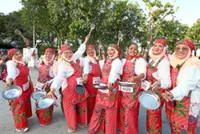Batch of honour: Yong (right) sees batik as a part of the Malaysian identity.
COLIN Yong believes it’s important to take pride in our Malaysian cultural heritage. That’s why the 49-year-old has made it his mission to rejuvenate the art of batik.
Interestingly, it took a trip to Japan – where he studied business administration at Hitotsubashi University – to spark his interest in batik.
Already a subscriber? Log in
Save 30% OFF The Star Digital Access
Cancel anytime. Ad-free. Unlimited access with perks.





